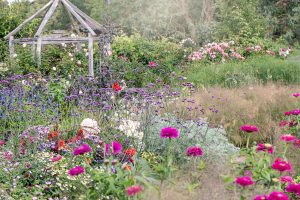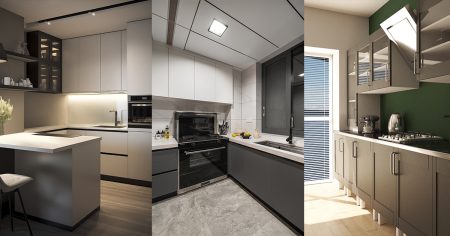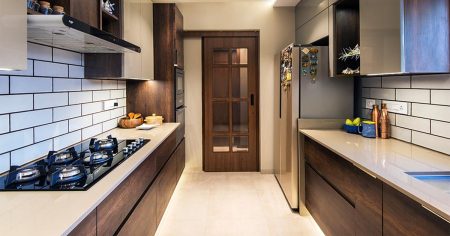Walls behind sinks and stoves in kitchens get splattered with food, grease, and water. So, a short backsplash often doesn’t do the job adequately. Enter the laminate sheet backsplash.
One of the best looks in kitchen and bathroom design is the full-wall sheet backsplash, often built from laminate countertop materials. It is the logical end result in backsplash evolution. Seamless, smooth, and often a solid color, it is better than any other backsplash material at protecting walls and at facilitating clean up. Increasingly found in designer kitchens, it is practically a staple of any type of kitchen that aspires to an ultra-modern, sleek style.
-
Seamless
-
Covers large areas
-
Scratch-free (for glass backsplashes)
-
Cracks may occur
-
Pro installation may be necessary
What Is a Laminate Sheet Backsplash?
Kitchens and bathrooms are high impact areas. The wall behind the sink and countertops is prone to moisture, while the area behind the stove is subject to heat and food splatter.
Tile this area with mosaic glass or porcelain tile, cover it with metal ceiling panels, or simply coat it with glossy paint—almost any water-resistant material or treatment can act as a backsplash.
Sheet backsplash is the catch-all term for a large, continuous sheet material that is used for a backsplash, usually behind a kitchen or bathroom counter. Also called a slab or panel backsplash, the purest version stretches horizontally for the entire length of the countertop and vertically from countertop to the bottom of the wall cabinets.
While any type of material can be used for a sheet backsplash, the most common material is countertop laminate. Laminate comes in large formats that, coupled reasonable costs, makes it ideal for creating sheet backsplashes.
Seamless Backsplashes For Easier Cleaning
The beauty of the sheet backsplash is that it provides protection with zero, or minimal, seams. Seams make kitchen clean-up difficult and are one reason why tiled countertops are not more widely installed.
Sheet backsplashes are in sharp contrast from those that are constructed of hundreds of smaller individual units such as tiles, which in turn create grouted seams. Seams collect dirt, need maintenance in the form of sealing, and can eventually fail.
Laminate Sheet Backsplash Features
- Height: Height is at least 18 inches, as that is the minimum distance between countertops and the bottom edge of wall cabinets. Sheet backsplashes rarely have horizontal seams.
- Length: Length is determined by the type of material you use, as some sheets have maximum production lengths. Granite slabs tend to be no longer than 105 inches; solid surface (for instance, brand name Corian) materials no more than 140 inches long, and retail-level sheet laminates max out at 144 inches.
- Single-Sheet: While one large piece is typically used as a sheet backsplash, some are formed from several large bonded panels. As long as these panels are imperceptibly seamed, they too qualify as sheet backsplashes. Solid surface and quartz are examples of two counter materials that can be bonded with nearly invisible seams.
- Costs: The installed cost for sheet glass backsplashes is about $50 to $80 per square foot. Quartz, stone, and solid surface backsplashes cost the same per square foot as countertop materials. A basic stock do-it-yourself laminate sheet backsplash can be installed for less than $5 per square foot.
- Colors: Solid color sheet backsplashes remain the most popular—a function of back-coated glass being the most popular material.
- Graphics: Large sheets of veined, striated marble are found in many kitchens. Laminate offers the widest range of non-solid visuals. Some designers like to use linen-look laminate for their sheet backsplashes.
Pros
- Cleaning: Continuous sheets mean no seams or cracks. Seams and cracks harbor food particles and other debris that hinder wipe downs.
- Seams: Because tile grout is porous, it needs to be sealed right after installation and then again on a regular basis.
- Appearance: Sheet backsplashes are found in many high-end kitchens. If you want to impart a premium look on an ordinary kitchen, a continuous backsplash is one way to do this.
- No-Scratch Finish: In the case of glass sheet backsplashes, the paint coat is applied to the backside of the glass and cannot scratch off from daily use.
Cons
- Professional Installation: Due to the large size of the material, sheet backsplash installation is usually best left in the hands of professional technicians.
- Crack Transference: One advantage of using individual units like tile is that cracks are contained within each unit. Rarely will cracks from one tile extend across a grout seam and onto other tiles. Because sheet materials have no containment methods, cracks that develop in one area can continue through the entire sheet.
Sheet Backsplash Materials
- Glass: Glass is a popular type of sheet backsplash material because of the back-coating process and because it is non-porous.
- Solid Surface, Quartz, Stone: Any kind of homogeneous material used for countertops—solid surface, quartz, and natural stone—can also be used as a sheet backsplash. Countertop thickness material can be prohibitively expensive, though. Solid surface is one countertop material that is available in a thinner, 1/4-inch version (countertop thickness solid surface is 1/2-inch thick).
- Countertop Laminate: Laminate materials are the most cost-effective way to create a sheet backsplash. Solid color laminate sheets can be purchased for as little as $2 to $5 per square foot at local home improvement stores and bonded to inexpensive medium-density fiberboard.
- Stainless Steel: Long used in restaurant kitchens for sinks, counters, and heat guards, stainless steel is a remarkably durable material that lends itself well to backsplashes.
Do-It-Yourself Sheet Backsplash Installation
Even though sheet backsplashes are most often installed by professional technicians, a number of do-it-yourselfers have managed to create their own with laminate and glass.
Laminate
Laminate is, by far, the easiest sheet material for the do-it-yourselfer to work with when building a large-format backsplash. While local home centers may only carry 8-foot long sheets, you can find 10-foot sheets at countertop distributors, if need be.
For vertical applications, the material must be bonded to #45 density particleboard, or MDF, that is at least 3/8-inch thick. Attach the MDF to the wall with adhesive or screw onto studs with small-headed screws.
Glass
Glass is more difficult but some do-it-yourselfers have successfully pulled off back-coated glass backsplashes. Due to cost and transportation issues, though, size may be limited.
Use spray paint to coat the back of the glass, applying several coats for an even, solid color. Or you may wish to mix several paints and streak them down for a fun, lively effect.
Read the full article here














